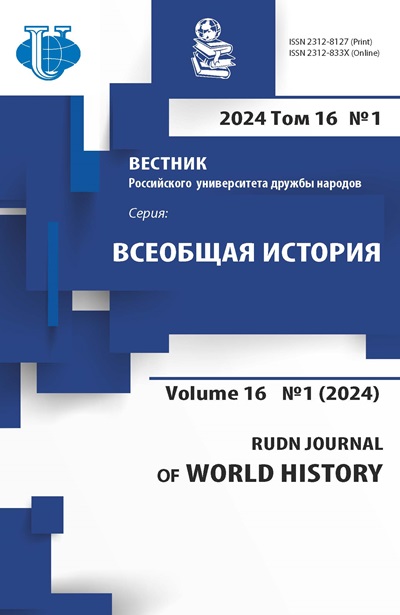“TATAR MUSCOVY”: THE CULTURAL AND POLITICAL ASPECT
- Authors: Asadullin FA.1
-
Affiliations:
- Institute of Oriental Studies, Russian Academy of Sciences
- Issue: Vol 9, No 2 (2017)
- Pages: 169-183
- Section: East and West: dialogue of civilizations
- URL: https://journals.rudn.ru/world-history/article/view/16539
- DOI: https://doi.org/10.22363/2312-8127-2017-9-2-169-183
Cite item
Full Text
Abstract
The article examines the influence of the Golden Horde on various aspects of the life of Russian principalities. The author draws attention to the fact that one of the main principles of the construction of the Moscow state has become ethnic and religious tolerance. Khan Uzbek has a special role in promoting the rise of Moscow as the church capital of the emerging Russian state, which marked the beginning of the history of the Moscow Patriarchate. The khan’s label issued to Metropolitan Theognost in 1326 served as an impetus for the establishment in Moscow of an Orthodox spiritual tradition and the centuries-old activity of the high priests of the Russian Orthodox Church. After the Troubles in the Golden Horde in the middle of the fourteenth century, the intensity of the Ordyn migration to Moscow intensified. Among the Tatar aristocracy a special social stratum of serving Tatars was formed, which through the rite of baptism and gradually assimilated with the Russian ethnos merged with the Moscow population. The strong influence of the Horde principle is found in the organization of military affairs, the fiscal system, Yamsk (transport) service, production and diplomatic protocol, certain behavioral stereotypes, details of everyday life and clothing, royal regalia. In addition, the article points to the wealth of the Moscow toponymy, which has a Turkic or Arabic origin. In the post-Ordin period, Islam and the lifestyle associated with it for a long time directly and indirectly played a significant role in the life of the capital and the entire Moscow state, which, after the fall of Byzantium in 1453 and the formation of the Ottoman Empire, was surrounded by Muslim states. This factor largely predetermined the formation of foreign policy priorities of the state.
About the authors
F Abdulovich Asadullin
Institute of Oriental Studies, Russian Academy of Sciences
Author for correspondence.
Email: a.farid@inbox.ru
ведущий научный сотрудник Института Востоковедения РАН, заместитель Председателя Духовного управления мусульман Европейской части России (Московского муфтията)
Rozhdestvenka St., 12, Moscow, Russia, 107031References
- Berdyaev N.A. The Russian idea // Questions of philosophy, 1990. No. 1, 2. [In Russ.]
- Gumilev L.N. From Rus' to Russia. M., 1992. [In Russ.] See also: Allsen Th. Mongol imperialism: the politics of the Grand all qan Mongke in China, Russia and the Islamic Lands, 1251-1259. Berkley, 1987.
- Karamzin N.M. Traditions of centuries. Tales from the «History of the Russian state». M., 1988. [In Russ.]
- Lay. M., 1968. [In Russ.]
- Kulpin E.S. The Golden Horde. M., 1998. [In Russ.]
- Tikhomirov M.N. Ancient Moscow in XII-XV centuries M, 1992. [In Russ.]
- Kuchkin V.A. Negotiated letters of the Moscow princes of the XIVth century: foreign policy instruments. M., 2003. [In Russ.]
- Cherepnin L.V. Formation of the Russian centralized state in XIV-XV centuries. M., 1960. [In Russ.]
- Izvestuya. 23.11.2007. Interview with the Chief archaeologist of Moscow Kremlin Tatiana Panova. [In Russ.]
- Tizengauzen VG. Collection of materials relating to the history of the Golden Horde: extracts from the writings of Arab. Vol. 1. SPb., 1884. [In Russ.]
- Landa R.G. Russia and the world of Russian Islam. M., 2011. [In Russ.]
- State emblem and the flag of Russia Xxx century. M., 1997. [In Russ.]
- Karamzin N.M. Traditions of centuries. M., 1988. [In Russ.]
- Macarius (Bulgakov). Metropolitan of Moscow and Kolomna. The history of the Russian Church. KN. 3. M., 1995. [In Russ.]
- Moiseev M.V. Leave of the «Tatars» and the Eastern policy of Russia in the XVI century // Foreigners in Russia in XV-XVII centuries. The collection of materials. M., 2006. [In Russ.]
- Velyaminov-Zernov V.V. Investigation of Kasimov kings and princes. SPb., 1863. [In Russ.]
- Vaskin A. Bull, who is eaten. About Fyodor Rostopchin and how the passion for politics is hurting literature // Nezavisimaya Gazeta - EX LIBRIS. June 28, 2012. [In Russ.]
- Baskakov N.A. Russian names of Turkic origin. M., 1979; Shamar A. Tatar stratum of Russian culture // Islam Minbar, 1995. No. 3-4. [In Russ.]
- Betonski M.A. Russia and Islam. T. I. Progress - Tradition. M., 2003. [In Russ.]
- Karamzin N.M. History of the Russian state. T. VII-IX. M., 1998. [In Russ.]
- See: Belyakov A.V. Genghis Khan in Russia XV-XVII centuries. Prosopographic research. Ryazan, 2011. [In Russ.]
- Berdyaev N. The origins and meaning of Russian communism. M., 1990. [In Russ.]
- Bartold V.V. Turkey, Islam, and Christianity. Vol. IV. M., 1966. [In Russ.]
- Plyukhanova B.M. Stories and symbols of Muscovy. SPb., 1995. [In Russ.]
- Kazan history / Prep. text, introd. word and notes G.N. Moiseeva. M.-L., 1954. [In Russ.]
- Murzaev E.M. Turkic geographical names. M., 1996. [In Russ.]
- Spiritual and contractual charters of the great and local princes in the XIV-XVI centuries. M., 1950. [In Russ.] Cit. by: Smolica G.P., Gorbanevsky M.V. Toponymy of Moscow. M, 1982.
- Pospelov E.M. Toponymic dictionary of the Moscow region. M., 2000. [In Russ.]
- Melentiev Y.S. About the «Golden ring» and connection times. M., 1990. [In Russ.]
- Kondrat'ev I.K. Gray old Moscow. M., 2002. [In Russ.]
- Khudyakov M. Essays on the history of the Kazan khanate. M., 1991. [In Russ.]
- Karamzin N.M. Note on Moscow memorable objects. M.,1820. [In Russ.]













